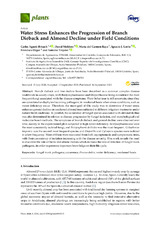Water Stress Enhances the Progression of Branch Dieback and Almond Decline under Field Conditions
Autor
Agustí-Brisach, Carlos
Moldero, David
Raya, María del Carmen
Lorite, Ignacio J.
Orgaz, Francisco
Trapero Casas, Antonio
Editor
MDPIFecha
2020Materia
Fungal trunk pathogensOccurrence
Prunus dulcis
Water deficiency
Weakened hosts
METS:
Mostrar el registro METSPREMIS:
Mostrar el registro PREMISMetadatos
Mostrar el registro completo del ítemResumen
Branch dieback and tree decline have been described as a common complex disease worldwide in woody crops, with Botryosphaeriaceae and Diaporthaceae being considered the most frequent fungi associated with the disease symptoms. Their behaviour is still uncertain, since they are considered endophytes becoming pathogenic in weakened hosts when stress conditions, such as water deficiency occur. Therefore, the main goal of this study was to determine if water stress enhances general decline on weakened almond trees subjected to different irrigation treatments under natural field conditions. In parallel, the occurrence of fungal species associated with almond decline was also determined in relation to disease progression by fungal isolation, and morphological and molecular based-methods. The symptoms of branch dieback and general decline were observed over time, mainly in the experimental plots subjected to high water deficiency. Botryosphaeriaceae were the most consistently isolated fungi, and Botryosphaeria dothidea was the most frequent. Collophorina hispanica was the second most frequent species and Diaporthe and Cytospora species were isolated in a low frequency. Most of them were recovered from both asymptomatic and symptomatic trees, with their consistency of isolation increasing with the disease severity. This work reveals the need to elucidate the role of biotic and abiotic factors which increase the rate of infection of fungal trunk pathogens, in order to generate important knowledge on their life cycle.

